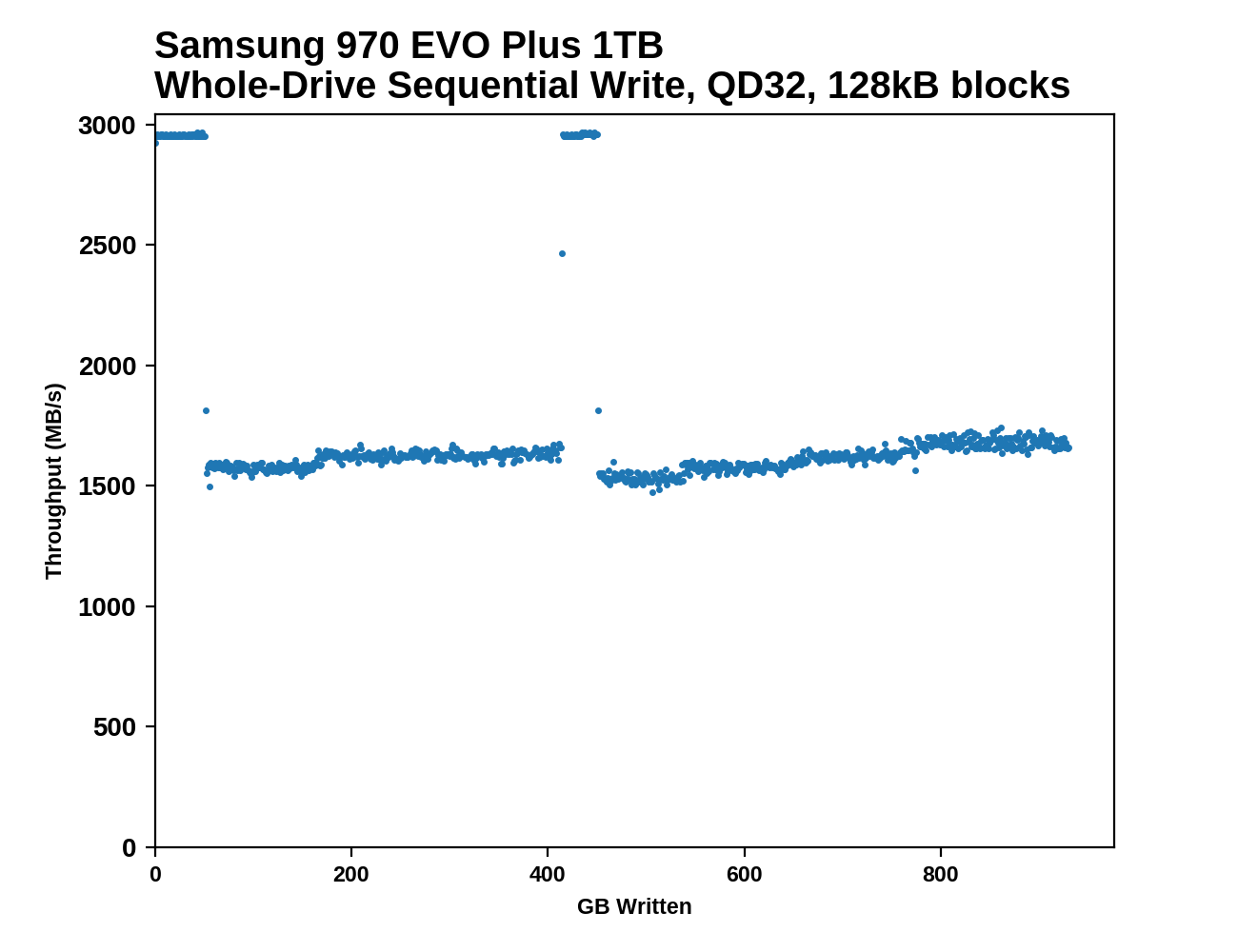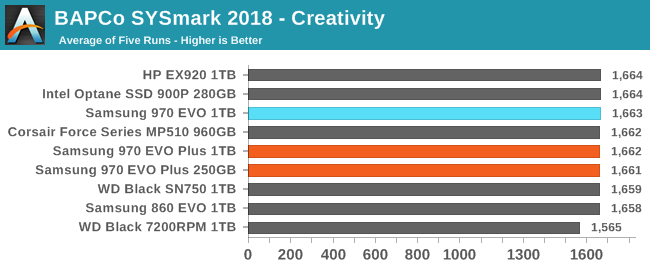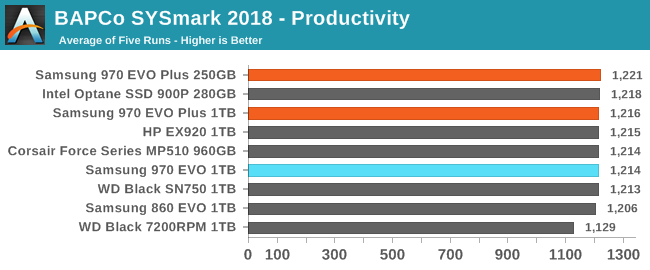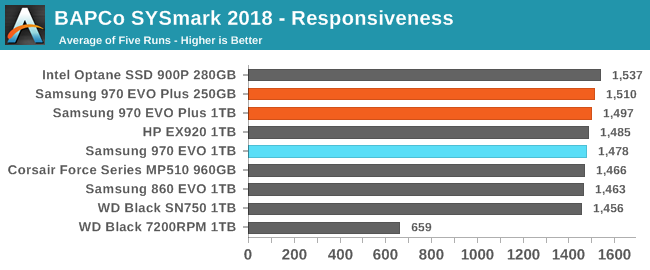The Samsung 970 EVO Plus (250GB, 1TB) NVMe SSD Review: 92-Layer 3D NAND
by Billy Tallis on January 22, 2019 10:00 AM ESTWhole-Drive Fill
This test starts with a freshly-erased drive and fills it with 128kB sequential writes at queue depth 32, recording the write speed for each 1GB segment. This test is not representative of any ordinary client/consumer usage pattern, but it does allow us to observe transitions in the drive's behavior as it fills up. This can allow us to estimate the size of any SLC write cache, and get a sense for how much performance remains on the rare occasions where real-world usage keeps writing data after filling the cache.
 |
|||||||||
Samsung obviously hasn't changed anything significant about the SLC caching behavior for the 970 EVO Plus: the cache initially runs out right on schedule, and the 1TB model still jumps back up to SLC speed for a short while when the drive is a little less than half full. The change to the underlying NAND does provide a performance boost to the write speeds before and after the cache fills up. The 240GB ADATA XPG SX8200 is an outlier among the small drives: it has a very large variable size SLC cache so it maintains high performance longer than the other drives in that capacity class, but once that cache is full it ends with one of the slowest write speeds.
 |
|||||||||
| Average Throughput for last 16 GB | Overall Average Throughput | ||||||||
The improvement to post-SLC sequential write speed isn't quite as big as the 970 EVO Plus specifications promise, but it's still plenty to make it the fastest TLC drive for this test, clearly surpassing the performance of even last week's new WD Black SN750. At the low end of the capacity range, the 250 GB model is well ahead of any other small TLC drive we have tested. It also looks like we are getting quite close to the point where the post-SLC write speed of a small TLC drive can saturate a SATA link, so if Samsung releases another generation of MLC SATA drives for the consumer market it may be impossible to measure any performance advantage over TLC NAND.
BAPCo SYSmark 2018
BAPCo's SYSmark 2018 is an application-based benchmark that uses real-world applications to replay usage patterns of business users, with subscores for productivity, creativity and responsiveness. Scores represnt overall system performance and are calibrated against a reference system that is defined to score 1000 in each of the scenarios. A score of, say, 2000, would imply that the system under test is twice as fast as the reference system.
SYSmark scores are based on total application response time as seen by the user, including not only storage latency but time spent by the processor. This means there's a limit to how much a storage improvement could possibly increase scores, because the SSD is only in use for a small fraction of the total test duration. This is a significant difference from our ATSB tests where only the storage portion of the workload is replicated and disk idle times are cut short to a maximum of 25ms.
| AnandTech SYSmark SSD Testbed | |
| CPU | Intel Core i5-7400 |
| Motherboard | ASUS PRIME Z270-A |
| Chipset | Intel Z270 |
| Memory | 2x 8GB Corsair Vengeance DDR4-2400 CL17 |
| Case | In Win C583 |
| Power Supply | Cooler Master G550M |
| OS | Windows 10 64-bit, version 1803 |
Our SSD testing with SYSmark uses a different test system than the rest of our SSD tests. This machine is set up to measure total system power consumption rather than just the drive's power.



The SYSmark Responsiveness test shows the 970 EVO Plus delivering slightly higher performance than any previous TLC-based SSD, but not quite enough to reach the level of the Intel Optane SSD 900P. Oddly, the 250GB 970 EVO Plus came out a bit ahead of the 1TB model. The other two scenarios—Creativity and Productivity—don't depend on storage performance enough to even show a meaningful difference between the 860 EVO SATA SSD and the fastest NVMe SSDs.
Energy Use
The SYSmark energy use scores measure total system power consumption, excluding the display. Our SYSmark test system idles at around 26 W and peaks at over 60 W measured at the wall during the benchmark run. SATA SSDs seldom exceed 5 W and idle at a fraction of a watt, and the SSDs spend most of the test idle. This means the energy usage scores will inevitably be very close. A typical notebook system will tend to be better optimized for power efficiency than this desktop system, so the SSD would account for a much larger portion of the total and the score difference between SSDs would be more noticeable.

The 970 EVO Plus required a bit less energy to complete a SYSmark run than the original 970 EVO did, but they're still relatively power-hungry compared to other NVMe SSDs, and good SATA SSDs use significantly less power. These differences don't seem like much in the context of our desktop testbed's total power draw, but in a laptop the performance of the 970 EVO Plus does come at some cost to battery life.










35 Comments
View All Comments
jaydee - Wednesday, January 23, 2019 - link
HP EX920 is still the best price/performance option by comfortable margin.kidfromthe90s - Thursday, January 24, 2019 - link
Barely noticeable in real life... unless you're doing massive FEA simulations like CFDsNotationMaster - Monday, March 11, 2019 - link
Which enclosure would you suggest for such a drive to use with a T3 equipped (USB-C only) MacBook Pro? Thank youstar-affinity - Thursday, March 21, 2019 - link
This:https://raidsonic.de/products/external_cases/exter...
Or this:
https://raidsonic.de/products/external_cases/exter...
Still they are just USB-C which means maximum 10 Gb/s transfer which will limit a NVMe drive such as the 970 EVO Plus quite a lot.
Haven't really found and any compact external M.2 enclosures that are bus powered over Thunderbolt 3. Maybe they exist? But there's this: https://vimeo.com/303171402
Margaronis - Thursday, April 11, 2019 - link
A good external tb3 case is the TEKQ Rapide. Recently reviewed on anandtech. One thing though, be aware that the samsung 970 evo plus in that case (or possibly any external case) does not play nice with MacOS. It’s a firmware issue, the non plus version is apparently fine, so TEKQ tell me as I’ve just fallen down that hole